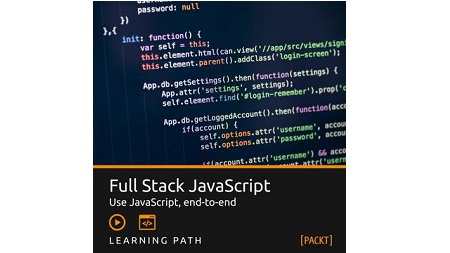
English | 2016 | MP4 | AVC 1280×720 | AAC 44KHz 2ch | 17.5 Hours | 4.03 GB
Use JavaScript, end-to-end
The increasing popularity of Node.js just goes to show how quickly developers are moving towards using one language across their development stack. In this Learning Path we’ll look at MongoDB, Express, AngularJS and Node.js as a comprehensive full-stack JavaScript solution that will help you embrace modern web development.
This path navigates across the following products (in sequential order):
- Mastering JavaScript (4h 10m)
- Web Development with Node.JS and MongoDB (3h 54m)
- Mastering Express Web Application Development (2h 51m)
- Learning Web Development with the MEAN Stack (2h 48m)
- Mastering MEAN Web Development (3h 36m)
Table of Contents
Mastering JavaScript
001.Using White Space for Readability
002.Declaring Variables
003.Declaring Complex Data Types and Functions
004.OOP Naming Conventions
005.Creating a Global Namespace
006.Constants (and Pseudo constants)
007.Smart Coercion of Data Fields
008.Targeting at JavaScript Versions or Features
009.Creating an onload Method That Always Works
010.OnReady – Our First Cross-browser Script
011.Using Modernizr to Detect Features
012.Building a Conditional Logic Flow
013.Selecting DOM Elements Natively in HTML5
014.Creating a Cross-browser Script Loader
015.Using Sizzle to Select DOM Elements
016.Defining a Namespace
017.Creating Private Variables in JavaScript
018.The JavaScript Module Design Pattern
019.Version Controlling Our Library
020.Building Out Our Library
021.Thinking with Interfaces
022.Creating an Adapter Design Pattern
023.Building a jQuery Adapter
024.Adding a Functionality Method
025.Mimicking the jQuery Wrapper
026.Introducing the Facade Design Pattern
027.Creating a Facade Creator
028.Creating a New Global Function Through the Facade
029.Creating an Advanced Facade Pattern
030.Creating a Singleton
031.Building the Constructor for Our Ticker
032.Connecting Time with Our Ticker
033.Processing Interval groups
034.Exposing Our Ticker to the World
035.Creating an Event Dispatcher
036.Integrating the Event Dispatcher into Our Library
037.Removing Events from the Dispatcher
038.Building Test Units
Web Development with Node.JS and MongoDB
039.Node.js Basics
040.Blocking Versus Non-blocking Code
041.Setting Up Your Environment
042.Hello Workout
043.CommonJS
044.Npm
045.The Event Loop
046.Working with Streams
047.Working with Files
048.Express.js Basics
049.MVC
050.Routing
051.Scaffolding an App
052.Templating with Handlebars
053.MongoDB Basics
054.NoSQL
055.Schema and Data Types
056.CRUD
057.Integrating with Node.js
058.Mongoose
059.RESTful APIs
060.Serving APIs
061.Consuming on the Server-side
062.Consuming on the Client-side
063.CRUD Through REST
064.Unit Testing and TDD
065.Mocha and Chai
066.Spying and Stubbing
067.Mocking with Sinon.JS
068.Running with Karma
069.Dependencies and SemVer
070.package.json
071.Publishing to npm
072.Heroku Basics
073.Deploying on Heroku
074.Optimizing Page Performance
075.Isomorphic JavaScript
076.Bundling with Webpack
077.Finishing the App
078.Final Remarks
Mastering Express Web Application Development
079.Configuration with nconf
080.Getting to Know Winston
081.Installing and Using Nunjucks
082.Consuming the Instagram API
083.Showing the Results on a Page
084.Caching Requests in Memory
085.Installing Mocha
086.Refactoring to Make Things Testable
087.Mocking to Remove Dependencies
088.Spying with Sinon.js
089.Installing Socket.io
090.Sending and Receiving Data in Real-time
091.Scoping Data to Individual Users
092.Adding a Chat Room
093.Middleware
094.Mounting Sub-applications
095.Serving Content Conditionally for AJAX
096.Persistance with Sequelize and MySQL
097.HTTPS and Express
098.Preventing CSRF
099.Using Helmet to Make Your App More Secure
100.Improving Performance with Node.js Cluster
101.Nginx and Node.js
102.Using Supervisord to Keep Things Running
103.ghost.org
104.Balloons.io
Learning Web Development with the MEAN Stack
105.The Course Overview
106.What Is the MEAN Stack
107.Installing WebStorm
108.Installing npm, Bower, and Grunt
109.Installing Test Suites
110.What Do All of These Tools Do
111.Hello, Mr. Grinch, Let’s Get MEAN
112.The Application Introduction
113.Getting Started
114.The Dashboard
115.Adding a Customer
116.Listing Customers
117.Editing a Customer
118.Adding a Sale
119.Listing a Customer’s Sales
120.Editing a Sale
121.Using the Angular Bootstrap Date Picker
122.Automated Seeding of Data
123.Dashboard – Monthly and Quarterly Sales
124.Dashboard – Unfulfilled Orders
125.Dashboard – Recent Orders
126.Node.js and MongoDB – Modeling in Mongoose
127.ExpressJS – Setting Up the Routes
128.AngularJS – Hooking Up the API
129.Full Stack – Adding a Customer
130.Full Stack – Adding a Sale
131.Node.js – Testing the Routes
132.Node.js – Testing the API
133.AngularJS – Testing the API
134.AngularJS – Testing the Controllers
135.AngularJS – Testing the Services
136.Grunt – Building a Distribution
137.Heroku – Publishing Your Code
138.Heroku – Setting Up the Database
139.Heroku – Setting Up Environment Variables
140.Viewing Your Application
141.Learning Helpful Plugins
142.Using the Tools
Mastering MEAN Web Development
143.Understanding the Caveats in Sublime
144.Course Overview
145.Installing the generator-mean-seed
146.Running Your Site
147.Web Debugger
148.Using Grunt
149.Configs
150.Pushing to GitHub
151.JavaScript, CSS, and HTML – the Frontend Building Blocks
152.JavaScript Callbacks and Promises
153.AngularJS – Our Frontend MVC Framework
154.Node.js and Express.js – Our Backend
155.MongoDB – Our Database
156.Scaffolding with -yo-
157.Using the Directive and Writing Template-HTML
158.Writing the Directive – Scope and Attributes
159.Writing the Directive – Controller
160.Writing and Running Unit Tests for the Directive
161.Scaffolding the New Page-Route-Controller with -yo-
162.Under the Hood of the ng-route Generator
163.Building and Accessing the New Page
164.Scaffolding the New Service with -yo-
165.Under the Hood of ng-service
166.Using the New Service
167.Writing Controller Tests – Boilerplate and Setup
168.Writing Controller Tests – the Tests
169.Unit Test the Code
170.Writing Service Tests – the Tests
171.Bower Search
172.Adding a New Bower Module
173.Using Your New Angular Module
174.Searching npm-nipster for a Module
175.Updating package.json and Running npm Install
176.Requiring a New Module and Using It
177.Scaffolding a New Route with -yo-
178.Under the Hood of the Node-controller Generator
179.Writing the API and Tests
180.Node Integration Test Coverage
181.Using the Interactive API Help Documentation
182.PageObjects for Modularization
183.Selectors and Filling in Forms
184.Writing Our First Test
185.Running with Grunt e2e
186.Promises and executeAsyncScript
187.Injecting and Using Angular Modules
188.Setup and Teardown with Mock Data
189.Interacting with Third-party Sites
190.Buying a Server
191.Setting Up the Server
192.Setting Up configs and Continuous Integration
193.Setting Up and Installing generator-mean-seed
194.Our Main Tools-Technologies
195.Angular
196.Node
197.Testing
198.Deploying
part 1 files 1-24
part 2 files 25-39
part 3 files 40-67
part 4 files 68-92
part 5 files 93-115
part 6 files 116-146
part 7 files 147-168
part 8 files 169-198
Resolve the captcha to access the links!